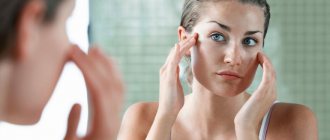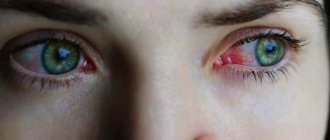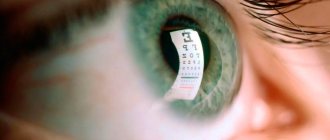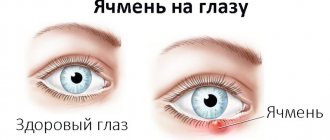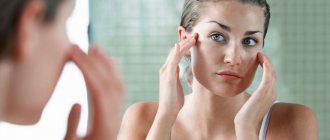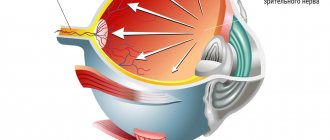Causes
Dry eye syndrome can develop for a wide range of reasons - from internal failures of the body to the external environment. But more often, a combination of factors leads to the development of chronic dryness.
Let's look at the main reasons:
- Long-term work at the computer - in the process of using a computer or other gadgets, the frequency of blinking is significantly reduced. This leads to dryness of the eye mucosa. If the person is in a room with dry air (for example, in an office with several computers), the situation gets worse;
- Age-related and hormonal changes – one of the reasons for the development of dry eye syndrome can be menopause in women;
- Quality of tear fluid - tears consist of water, mucin and lipids. If the percentage of any of the tear components decreases, the normal nutrition of the eye is disrupted. For example, if there are not enough lipids in the tear, the liquid will quickly evaporate, resulting in chronic dryness;
- The quality and volume of tear fluid produced can be affected by various diseases, including diabetes or rheumatoid arthritis. Pathology can also develop while taking medications. As a rule, these are antihistamines or anti-inflammatory drugs, as well as COCs;
- Lack of sleep combined with other factors can lead to the development of the disorder.
Symptoms
Dry eye syndrome can present with a wide variety of individual symptoms. Classic clinical manifestations include dry burning and gritty pain in the affected eye, foreign body sensation, increased (and useless) lacrimation, painfully heightened reaction to bright light, blurred vision, asthenopia (eye fatigue), redness, a variety of discomfort and pain on palpation , washing, instillation, etc. As a rule, there is a worsening of the existing symptom complex in the evening, in the cold or in strong winds, with more or less prolonged visual concentration, as well as in dry, smoky or dusty rooms.
When examining, the ophthalmologist pays attention to organic changes in the conjunctiva and cornea specific to xerosis (the presence and nature of the so-called tear menisci), a tendency to “stick” during the act of blinking, displacement of the swollen edematous conjunctiva, erosions, signs of filamentous keratitis, etc. In some severe forms, signs of not only inflammation, but also degeneration are observed: a decrease in the transparency, smoothness, and uniformity of the corneal layer, its excavation (“pitting”), a decrease in the natural shine of the eyes, and hyperemia. The recurrent erosive variant is manifested by periodic microscopic ulcers on the cornea, which heal within a few days, but leave behind long-lasting discomfort.
A particularly severe degree of keratoconjunctival xerosis can develop as a result of chronic complete or partial non-closure of the eyelids. A profound deficiency of vitamins A results in scaly metaplasia of the corneal epithelium and keratin degeneration of the conjunctiva. In many cases, dry eye syndrome is accompanied by inflammation of the eyelids (blepharitis). In the absence of timely and adequate treatment, the outcome of dry eye syndrome can be irreversible destructive changes in the cornea, including perforation.
Diagnostics
The above and other known manifestations of dry eye syndrome serve as primary diagnostic criteria for the ophthalmologist. Of great importance for establishing a diagnosis is also the analysis of complaints, heredity, life history, and the dynamics of the disease. In general, a pathognomonic (inherent only to this disease and not typical for others) clinical picture is usually collected, which allows reliably diagnosing dry eye syndrome. Additional informative signs may include the dermatological and motor status of the eyelids (in particular, the frequency of blinking), the results of a biomicroscopic examination of the tear film, corneal and conjunctival surfaces, tear menisci, etc. A contrast fluorescent test may be prescribed to assess the homogeneity of the tear layer, tests of secretory productivity and volatility of the tear fluid (Schirmer, Norn tests, etc.).
Measurements of the various layers in the “lubricating coating” at the micron level are made in polarized light (thiascopy). If a more in-depth diagnostic examination is necessary, laboratory tests of osmolarity, crystallography, and cytological examination are prescribed. In the presence of background endocrine or autoimmune disorders, the current clinical status of the relevant systems is diagnosed.
Diagnostics
The patient may suspect chronic dry eyes, but to confirm the diagnosis and receive a treatment plan, it is necessary to visit an ophthalmologist
. The specialist will begin the appointment by collecting an anamnesis, after which the patient will have to undergo a set of diagnostic procedures:
- External examination, during which the doctor assesses the condition of the eyelids, the degree of their closure, as well as the frequency of blinking;
- Biomicroscopy of the eye, which is performed using a slit lamp, allows you to assess the condition of the tear film;
- Additional tests and samples, for example, the Schirmer test, which allows you to determine the rate of formation of fluid in a tear.
If necessary, the doctor can also take a smear for cytological examination. If during the appointment the ophthalmologist suspects the presence of systemic diseases that provoke xerophthalmia, the patient may be prescribed additional examination by specialized specialists.
Only after diagnosis can the doctor choose the appropriate treatment.
Stages of the disease, its symptoms
In its development, dry eye syndrome goes through 4 stages:
I. Mild stage
The first “bells” of the disease appear sporadically and do not cause any particular trouble: the patient feels a burning sensation, complains of “sand in the eyes” and photophobia. Most often, he attributes his condition to ordinary overwork.
Stage I symptoms: increased compensatory lacrimation, swelling.
II. Middle stage
Signs of the disease become more and more noticeable and remain, even if the supposed cause - computer, fatigue - has been eliminated.
Stage II symptoms: the amount of tear secretion decreases, and is replaced by a feeling of dryness in the eye. There is an increase in burning and stinging, and pain appears when using eye drops.
III. Severe stage
The patient is constantly accompanied by severe discomfort, which does not depend on external influences on the organ of vision.
Stage III symptoms: epithelial filaments form on the cornea, one end attached to the epithelium - this condition is called filamentous keratitis. Later it develops into keratoconjunctivitis sicca - pathological dryness of the conjunctiva and cornea. The cornea becomes dull, opacities appear on the epithelium, redness, and severe swelling.
IV. Particularly difficult stage
Soreness, dryness, and decreased vision lead to a significant deterioration in the patient’s quality of life.
Stage IV symptoms: microdefects and ulcerations appear on the cornea. The tear film breaks. If the patient is left untreated, corneal degeneration can become irreversible and lead to complete blindness.
Eye rubbing due to dry eye syndrome
Treatment of dry eye syndrome
For mild xerophthalmia, patients are prescribed artificial tear drops. They supplement the natural tear fluid and provide long-lasting and uniform hydration of the surface of the eye. Drops must be used regularly throughout the day.
If the patient's condition is more severe, the doctor
may prescribe prescription drops to stimulate natural tear production.
Self-medication or the use of traditional methods is unacceptable - this can aggravate the patient’s condition.
Folk remedies
Traditional medicine recipes recommend using such remedies as aloe juice, a solution of propolis and honey in the form of drops, applying cucumbers and bags of tea to the eyelids. Rinsing the eyes with infusions of chamomile, calendula and eyebright.
However, it is worth understanding that these traditional methods do not help solve the problem, but only lead to infection and allergic reactions, which only aggravates the situation.
Severe dry eye syndrome with a xerotic ulcer or severe keratomalacia may require, if other methods are ineffective (in particular, conservative therapy and/or obstruction of the lacrimal drainage tract), operative keratoplasty. Laser tarsorrhaphy (a high-tech radical technique for suturing the edges of the eyelids) is indicated for non-closure or inadequate closure of the eyelids, an abnormally widened palpebral fissure, or a pathologically rare blink reflex. The latest developments in this area are autotransplantation of salivary glands into the conjunctiva, implantation of special lacrimal reservoirs, etc.
Dry eye syndrome and contact lenses
In rare cases, contact correction products may contribute to the development of dry eye syndrome. For example, if the patient uses the wrong solution or purchases low-quality lenses. In this case, you need to consult with a specialist and choose a more suitable product, and also buy lenses only from specialized opticians.
It should also be noted that when xerophthalmia occurs, the use of contact lenses becomes difficult. In the early stages, the patient may experience minor discomfort, which can be minimized with the use of moisturizing drops. However, if the disorder has reached a high degree, the patient cannot even wear contact correction devices.
Dry eyes in the morning: how to cure?
Table of contents
Causes of dry eye in the morning What is dry eye syndrome?
Symptoms and diagnosis of dry eye How to cope with morning dry eyes? Gilan solution to eliminate dry eyes Oddly enough, if your eyes stick together in the morning, you should think about your health. This symptom indicates xerophthalmia - dry eye syndrome, which develops as a result of loss of stability of the tear film.
Causes of dry eyes in the morning
Morning dry eyes are a consequence of insufficient hydration of the cornea and conjunctiva. Tear fluid deficiency occurs under the influence of a variety of factors:
- insufficient humidity of the indoor microclimate;
- high air temperature;
- working in hazardous conditions;
- smoking before bed;
- taking vasoconstrictor drugs;
- overvoltage from prolonged work at the computer.
In each case, the cause of xerosis is individual, and, as a rule, it is associated with chronic or congenital diseases of the immune system, skin and mucous membranes, cardiovascular system, connective tissue, and ophthalmological diseases.
The cause of dry eyes after waking up may be dry eye syndrome, which develops due to dysfunction of the meibomian (sebaceous) glands. When the secretion of the lacrimal glands decreases, viscous white mucus accumulates in the corners of the eyes and on the eyelids, which sticks them together during sleep.
Dry eyes at night occur due to hormonal disorders that cause disruption of the composition of tears. It evaporates quickly, which is why there is a burning sensation and “sand” under the eyelids.
What is dry eye syndrome?
Dry eye syndrome is a disease characterized by drying of the cornea. The tear film, which is responsible for its hydration, has a three-layer structure. Each layer performs a separate function: aqueous - moisturizes, tear - cleanses, lipid - nourishes. If any of the components stops functioning fully, dry eye syndrome occurs.
Symptoms and diagnosis of dry eye
What are the signs that suggest DES?
- Dry eyes after waking up and in the first half of the day.
- Sticking of eyelids during sleep.
- Feeling of burning and itching in the eyes.
- Decreased visual acuity.
- Increased lacrimation.
- Redness of the eyes.
- Inflammation of the conjunctiva.
Symptoms of dry eye syndrome are similar to those of conjunctivitis and allergies, so a reliable diagnosis is made based on the results of a fluorescein test and examination of the surface of the cornea.
The test determines the time it takes for the tear film to break, and during the examination the doctor will be able to see erosions or mucins on the cornea, which inevitably appear as the disease progresses. Depending on the nature of the complaints, other diagnostic methods are also used: Schirmer's test, nasal, canalicular test, test for the patency of the lacrimal ducts.
How to deal with morning dry eyes?
Dry eye syndrome is curable, but only if the treatment option is selected by a qualified ophthalmologist. Various folk remedies, eye drops and broad-spectrum ointments can relieve symptoms for a short time, but do not eliminate the problem. The most effective means today are “artificial tears” preparations, which in their composition imitate natural tear fluid.
Gilan solution to eliminate dry eyes
Ophthalmic solution "Gilan" is a domestically produced substitute for natural tears. Thanks to hyaluronic acid, it provides a long-lasting moisturizing effect and helps restore the healthy structure of the tear film.
The drug helps not only with dry eyes in the morning, but also in all cases when the patient is diagnosed with dry eye syndrome. Suitable for older people and those who constantly use soft contact lenses.

